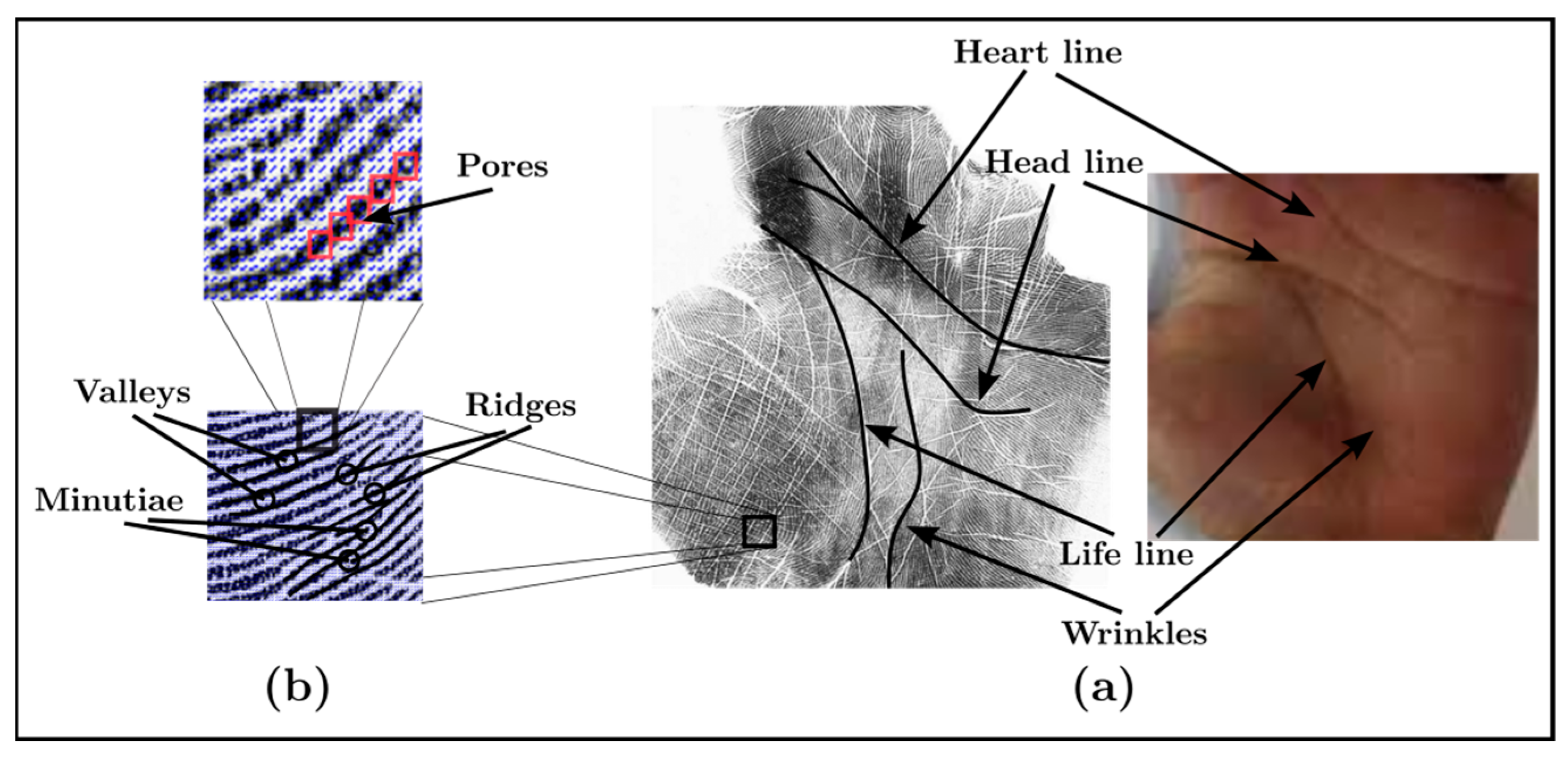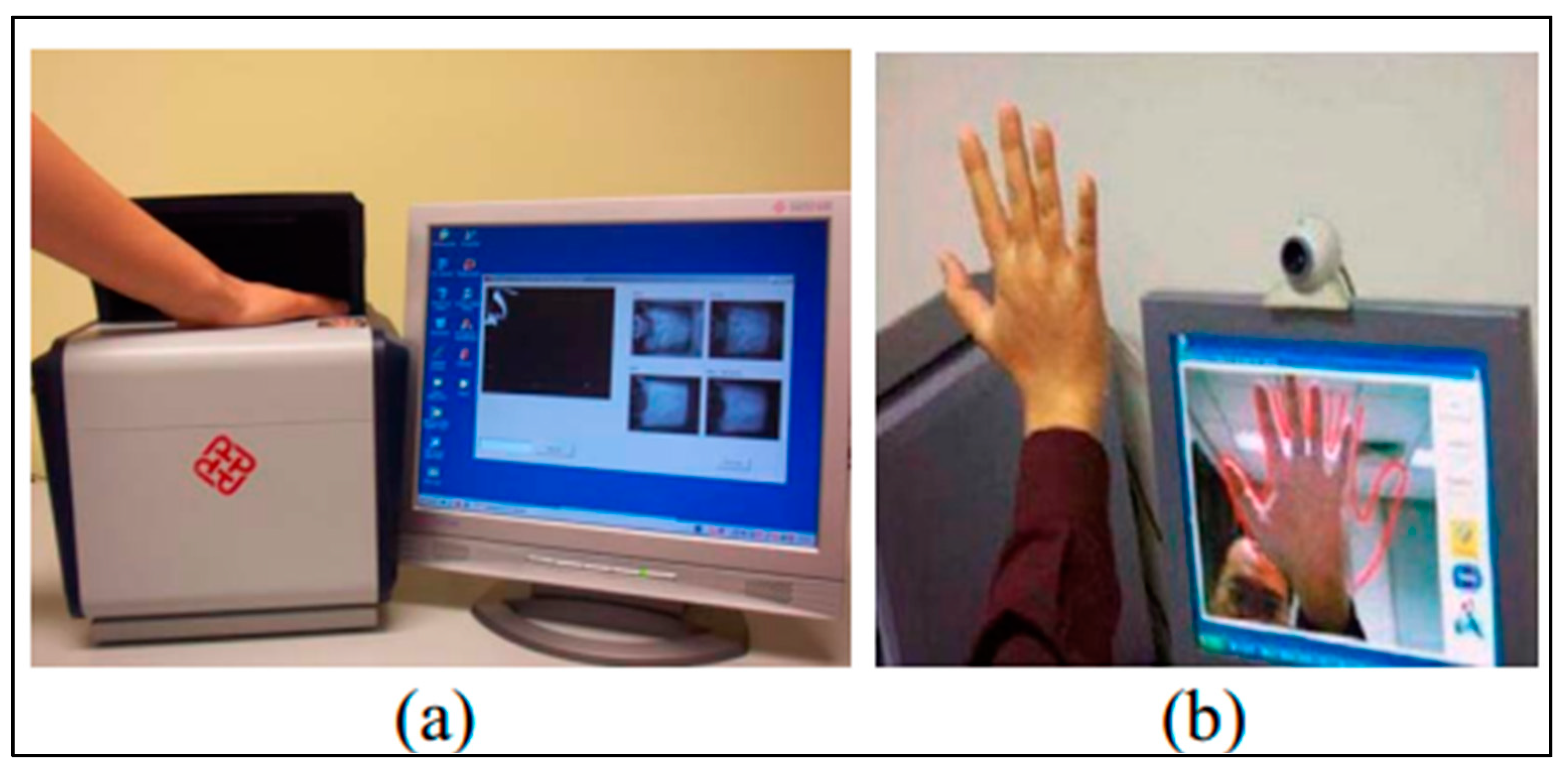Palmprint recognition constitutes a pivotal biometric technology deployed in the identification and verification of individuals, relying on the distinctive patterns inherent in their palmprints. This method, known for its reliability and security, finds extensive applications in diverse fields, including access control, security systems, and forensic investigations. Palmprint image acquisition involves capturing high-quality palmprint images using various devices like cameras, scanners, or smartphones. These images are then subjected to preprocessing techniques, encompassing noise reduction, normalization, and enhancement, to ensure consistent submission despite any restrictions on the availability of materials and/or refined input data. Following preprocessing, relevant features are extracted, like minutiae points specific to an individual’s palm, ridges, and lines. These features are crucial for accurate identification and are obtained through advanced image processing methods.
1. Introduction
Palmprint recognition constitutes a pivotal biometric technology deployed in the identification and verification of individuals, relying on the distinctive patterns inherent in their palmprints. This method, known for its reliability and security, finds extensive applications in diverse fields, including access control, security systems, and forensic investigations
[1]. The palmprint recognition methodology originated with a focus on forensic analysis of latent prints, capitalizing on the intricate and extensive textural features compared to fingerprints. In forensic applications, high-resolution images exceeding 400 dots per inch (dpi) are utilized to capture detailed structural information. In contrast, civil and commercial systems, such as access control, opt for lower resolutions under 150 dpi to balance utility and practicality. The larger surface area covered by palmprints allows for highly discriminative characterization, even in low-quality images. The resolution-field condition trade-off underscores the differing goals: Forensic usage requires definitive one-to-one matching for evidence, whereas access control emphasizes immediate user authentication and system integration. A comprehensive understanding of these contexts and their implications on image quality, feature representation, and matching algorithms is crucial for adapting palmprint recognition to diverse application needs. The process of palmprint recognition entails several fundamental stages: image capture and acquisition, preprocessing for normalization and enhancement, descriptive feature extraction, and finally, pattern matching for classification.
Palmprint image acquisition involves capturing high-quality palmprint images using various devices like cameras, scanners, or smartphones. These images are then subjected to preprocessing techniques, encompassing noise reduction, normalization, and enhancement, to ensure consistent submission despite any restrictions on the availability of materials and/or refined input data. Following preprocessing, relevant features are extracted, like minutiae points specific to an individual’s palm, ridges, and lines. These features are crucial for accurate identification and are obtained through advanced image processing methods
[2].
Palmprint recognition systems possess notable advantages—notably their non-intrusive nature, stability of features over time, and the abundance of unique identifying characteristics on the palm
[3]. However, challenges persist, including variations in illumination, pose, and image quality, necessitating meticulous attention for precise and dependable recognition outcomes.
Sustained research efforts, especially within image processing, machine learning, and deep learning, have significantly enhanced palmprint recognition systems. These advancements have solidified the integration of palmprint recognition as an indispensable component within contemporary biometric security applications
[4].
Despite promising advancements in palmprint recognition, numerous unresolved issues and open challenges persist in the field. These challenges encompass diverse factors such as changes in pose, occlusion, blurring, image resolution, and the synthesis of palmprints
[5][6]. Successfully addressing these challenges requires substantial efforts aimed at enhancing palmprint acquisition, normalization techniques, and recognition algorithms. Such efforts are crucial for deploying palmprint recognition within forensic analysis, surveillance systems, mobile phone security, and various commercial applications.
2. What Is a Palmprint?
The palmprint refers to the unique pattern of ridges and valleys found on the inner surface of the hand, excluding the wrist and fingers. Palmprints, akin to fingerprints, are a biometric characteristic unique to each individual. A seminal study by Shu and Zhang in 1998
[7] explored the viability of palmprints as a means of personal identification, establishing them as a form of physical biometrics. Their findings highlighted distinctive features in palmprints, including major lines (life, heart, and head lines), wrinkles, minutiae, and delta points. Each palmprint is unique, and the surface of the palm provides more information space compared to fingerprints, so it contains a greater amount of information.
In general, the attributes of the palmprint manifest on multiple levels, each discernible in various types of palmprint images. Typically, these characteristics are visible across different image resolutions, with lower resolution, around 100 pixels per inch (ppi)
[8][9], exhibiting a pronounced texture in which dark lines are of particular significance and visibility. Notably, among these lines, the three widest and longest are termed major lines, constituted by the heart line gathering with the head and life lines, and the remaining lines are referred to as wrinkles
[10], as illustrated in
Figure 1. Therefore, in the case of low-resolution images, the predominant features are the major lines, wrinkles, and texture. Nevertheless, the edges of the palmprint remain imperceptible in images of low resolution. In contrast, visibility can be achieved in the case of images with high resolution, of approximately 500 dpi, which unveils local texture intricacies, including minute creases, ridges, valleys, and minutiae points
[10]. Furthermore, images with very high resolution allow an abundance of certain local particular features related to the palmprint to be visualized, including the pores, which can be seen in resolutions exceeding 500 ppi or even reaching 1000 ppi.
Figure 1. Palmprint characteristics (a) at low resolution and (b) at high resolution.
3. Why Palmprint Recognition?
In the field of biometric recognition, facial identification still has limitations due to persistent challenges, such as pose, lighting, and orientation variations
[11]. Conversely, fingerprints have been widely adopted due to their efficiency, although certain populations, such as manual workers and the elderly, may have difficulty with capturing fingerprints. In a networked society, reliable personal authentication remains critical for security
[12]. Compared to other biometric modalities, palmprints have proven to be more effective and acceptable. The palmprint biometric system offers higher accuracy than fingerprints and higher acceptance than facial recognition. With characteristics such as uniqueness, reliability, and security, palmprints have been widely adopted by security agencies, providing a cost-effective and non-intrusive option for developing accurate and efficient biometric systems.
Advanced research in palmprint feature extraction
[13][14] has been conducted for contactless systems. Contactless palmprint recognition aims to improve usability and privacy. However, the lack of a knuckle guide can lead to variations in palmprint images due to hand movements. Various methods, such as the utilization of texture operators like local binary pattern (LBP)
[15] and Gabor filters
[16], were proposed to overcome these challenges.
Palmprint has advantages over other biometric methods, including iris and fingerprint, in terms of identity matching. Palmprints offer the advantage of easy capture with low-resolution devices, mitigating the high costs associated with other modalities. Moreover, law enforcement agencies have extensively employed palmprints for criminal identification, leveraging their unique and stable characteristics
[17][18]. These prints encapsulate diverse features like primary lines, minutiae points, ridges, and overall texture. Each feature class contributes significantly to the individuality and discriminative power of a palmprint. This flexibility permits adaptation to the specific security requirements of individuals and organizations.
4. Structure of a Palmprint Recognition System
As delineated in
Figure 2, the palmprint recognition framework structure encompasses four key stages similar to broader biometric architectures—(i) image acquisition, followed by (ii) preprocessing and (iii) feature extraction, and culminating with (iv) classification
[19]. The preprocessing stage aims to enhance image performance and remove extraneous elements. Then, the process moves to the feature extraction stage, which allows features to be elicited from the image of the palm through advanced image analytics. Finally, the image proceeds to the classification stage, where it undergoes classification to match image samples with individuals and identify the closest match in the database to the palmprint used in the test.
Figure 2. Architectural framework of a palmprint recognition system.
4.1. Image Acquisition
Contingent on the imaging apparatus, palmprint acquisition methodologies bifurcate into contact-based palmprint images and contactless ones
[14]. The first category necessitates direct palm-sensor contact; however, the second one involves no direct physical contact. Indeed, in the first case, images are acquired with palms placed on the device and hands guided by positioning markers for the user. Conversely, in the second scenario, images are captured without any physical contact with the device.
Figure 3 illustrates both modes of palmprint image acquisition, with and without contact
[20][21].
Figure 3. Two characteristic approaches for palmprint image acquisition: (a) physical contact palmprint image capturing method and (b) contactless palmprint image capturing model.
4.2. Preprocessing
Image preprocessing involves denoising and smoothing the region of interest (ROI) in the entered data before deriving significant features within the palmprint images. ROI extraction in palmprint recognition adverts to the process of identifying and isolating the specific area of a palmprint image that contains the most relevant and distinctive features for recognition purposes
[22]. This extraction is critical for accurate feature analysis and comparison within a recognition system. Various techniques are used to extract the ROI, which typically involves locating the central area of the palmprint image where key features like lines, ridges and minutiae points are concentrated.
The ROI extraction process aims to enhance the ability and the fineness of palmprint recognition systems by focusing computational efforts on the most informative part of the palmprint image. This targeted approach ensures that only the relevant features are considered during feature extraction and comparison, resulting in more reliable and accurate recognition results. Proper ROI extraction methods are essential for achieving optimal performance in palmprint recognition systems, making it a fundamental step in the overall recognition process.
Figure 4 highlights an example of the preprocessing module of the palmprint identification system, comprising five essential stages
[23].
Figure 4. Example of preprocessing steps for a palmprint image. (a) image acquisition, (b) palm contour extraction, (c) key point detection, (d) establishment of a coordinate system, and (e) extraction of central parts.
4.3. Feature Extraction
Feature extraction captures distinctive features from biometric data to create a unique digital representation of the palmprint. Algorithms transform raw data into discriminative features used for identification or verification. These features must be invariant to irrelevant variation and highlight fundamental characteristics. The following methods are most commonly used in palmprint feature extractison: line-based, subspace learning-based, local direction encoding-based, texture descriptor-based, and deep learning-based methods.
4.4. Classification
During recognition, the features derived from the entered palmprint are compared with the features stored in a database. Various matching algorithms, such as Euclidean distance or neural networks, are used to determine the similarity between the input features and the stored templates.
4.5. Evaluation Performances
The valid accuracy and equal error rate (EER) serve as widely accepted metrics for evaluating the performance of biometric systems. These metrics are fundamental in judging the effectiveness of such systems and are commonly utilized in the field. Valid accuracy assesses the overall correctness of the system in authenticating users, indicating its capability to accurately identify legitimate users. Conversely, the EER stand as a pivotal metric in evaluating biometric system performance. It pinpoints the precise operating condition where the false acceptance rate (FAR) and false rejection rate (FRR) converge equally, signifying an equilibrium assessment of the system performance.
The valid accuracy is the percentage of correctly accepted genuine instances or positive matches in the biometric system, which can be obtained through:
where:
True acceptances: the number of instances where the biometric system correctly accepts a genuine user.
Total number of genuine instances: the total number of instances where a genuine user attempts authentication.
The EER serves as an equilibrium point between the two error rates, which allows the FAR and FRR to intersect.
where:
It is important to note that lower EER values indicate better performance in terms of balancing the false acceptance rate (FAR) and false rejection rate (FRR).
In an ideal system, the recognition rate would be 100% and the EER would be 0%. However, in practice, there is often a trade-off between these two metrics, and system designers aim to find a balance that meets the requirements of the specific application.









